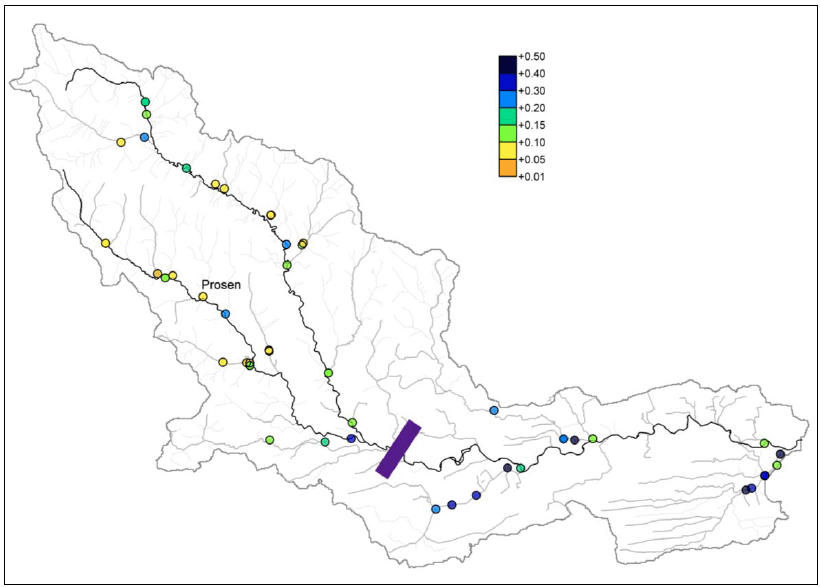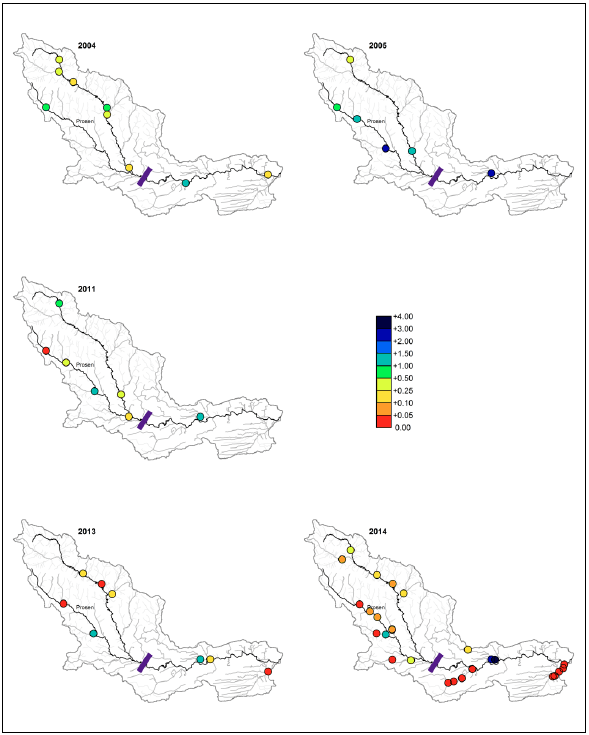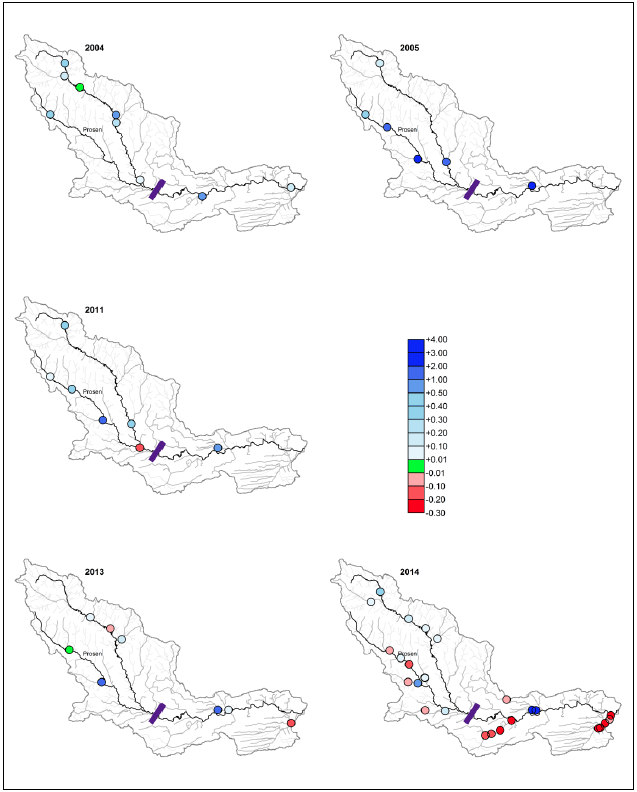Spring salmon on the River South Esk, Scotland: Scottish Marine and Freshwater Science Vol 7 No 10
Report of a three year project carried out by Marine Scotland to investigate the spring component of the River South Esk salmon stock.
Part 3: The status of the juvenile salmon stock
Objective: How does the status of the juvenile salmon stock vary within the River South Esk and how does this relate to spawning regions used by spring fish?
3.1 Introduction
Juvenile assessments are often used to determine the health of fish populations and contribute towards status assessments under the Water Framework Directive ( SNIFFER, 2011 b) and EU Habitats Directive (Godfrey, 2005). Due to density dependent processes, juvenile assessments are potentially less sensitive than other metrics of fish population health, at least at relatively high densities, but can still be a useful indicator where spawner numbers drop below saturation levels or where there are problems with local habitat quality that prevent successful recruitment.
Electrofishing is the most commonly applied sampling approach for juvenile salmonids. Where quantitative multi-pass electrofishing is performed, estimates of capture probability can be obtained. Given estimates of capture probability, it is possible to scale the observed fish numbers, to the total numbers of fish estimated to occur at a site (Millar et al., 2015).
One of the greatest challenges in juvenile salmon assessment relates to the interpretation of data obtained by electrofishing. To determine whether observed salmon numbers are adequate, it is first necessary to determine the expected numbers under natural environmental conditions. Juvenile salmon densities vary in response to a wide range of biotic and abiotic habitat variables including water quality, depth, velocity, substrate, cover and food availability (Armstrong et al., 2003). Although it is not possible to measure all these variables at the large spatial and temporal scales required for salmon assessment, it is possible to model salmon densities in relation to habitat proxies, often obtained from a Geographical Information System ( GIS). Such an approach was recently described by Millar et al. (2015) for Scotland and provides the basis for interpreting electrofishing data in this report. Specifically, observed densities from electrofishing on the River South Esk were compared with the national fish density model described by Millar et al. (2015) to assess whether sites are performing better or worse than expected given the habitat characteristics of the river. Due to the potential for status to change over time, data are presented for each year of the study (2013 and 2014) and compared with historical data (2004, 2005 and 2011), to determine if there is any obvious temporal variation in numbers of salmon fry across sites.
In the context of the current investigation, radio tracking has shown that early running spring salmon spawn predominantly in the upper South Esk (see Section 2). Therefore, it seems reasonable to assume that the status of electrofishing sites in the upper catchment are broadly indicative of the health of spring salmon stocks and it is on this basis that that the electrofishing data are interpreted.
3.2 Methods
Electrofishing data
Only quantitative electrofishing data containing more than two passes was included in this report. Historical electrofishing data were obtained from Scottish Natural Heritage ( SNH) for the years 2004 and 2005 (Godfrey, 2005), and from the Scottish Fisheries Co-ordination Centre ( SFCC) database for 2011. Additionally, Marine Scotland Science undertook programmes of electrofishing in 2013 and 2014 in support of this project. A summary of available data is provided in Table 3.2.1.
Table 3.2.1: Summary of available electrofishing data.
| Year | Date | Easting | Northing | Number of passes | Data Source | Area fished (m 2) |
|---|---|---|---|---|---|---|
| 2004 | 01/09/2004 | 330489 | 774254 | 3 | SNH | 372 |
| 2004 | 01/09/2004 | 336311 | 769818 | 3 | SNH | 136 |
| 2004 | 01/09/2004 | 336353 | 768610 | 3 | SNH | 355 |
| 2004 | 02/09/2004 | 340149 | 759445 | 3 | SNH | 155 |
| 2004 | 02/09/2004 | 349945 | 756805 | 3 | SNH | 152 |
| 2004 | 02/09/2004 | 325779 | 769888 | 3 | SNH | 228 |
| 2004 | 05/08/2004 | 364147 | 758240 | 3 | SNH | 592 |
| 2004 | 31/08/2004 | 328095 | 778108 | 3 | SNH | 337 |
| 2004 | 31/08/2004 | 328043 | 776048 | 3 | SNH | 220 |
| 2005 | 08/07/2005 | 325779 | 769888 | 3 | SNH | 136 |
| 2005 | 08/08/2005 | 328095 | 778108 | 3 | SNH | 241 |
| 2005 | 22/09/2005 | 334178 | 762769 | 3 | SNH | 46 |
| 2005 | 22/09/2005 | 329253 | 767866 | 3 | SNH | 77 |
| 2005 | 27/09/2005 | 352457 | 758502 | 3 | SNH | 53 |
| 2005 | 27/09/2005 | 338751 | 762338 | 3 | SNH | 48 |
| 2011 | 01/08/2011 | 328095 | 778108 | 3 | SFCC | 96 |
| 2011 | 06/10/2011 | 325779 | 769888 | 3 | SFCC | 125 |
| 2011 | 23/08/2011 | 334173 | 762925 | 3 | SFCC | 37 |
| 2011 | 23/08/2011 | 329253 | 767866 | 3 | SFCC | 77 |
| 2011 | 29/07/2011 | 352457 | 758502 | 3 | SFCC | 98 |
| 2011 | 29/09/2011 | 338751 | 762338 | 3 | SFCC | 73 |
| 2011 | 31/07/2011 | 340090 | 758522 | 3 | SFCC | 80 |
| 2013 | 11/09/2013 | 332177 | 773323 | 3 | MSS | 56 |
| 2013 | 11/09/2013 | 333988 | 762936 | 3 | MSS | 83 |
| 2013 | 18/09/2013 | 335398 | 771511 | 3 | MSS | 41 |
| 2013 | 18/09/2013 | 337218 | 769781 | 4 | MSS | 85 |
| 2013 | 24/09/2013 | 364178 | 756374 | 3 | MSS | 47 |
| 2013 | 25/09/2013 | 354159 | 758510 | 3 | MSS | 31 |
| 2013 | 25/09/2013 | 352456 | 758508 | 3 | MSS | 50 |
| 2013 | 27/09/2013 | 328813 | 768113 | 3 | MSS | 71 |
| 2014 | 02/09/2014 | 335343 | 758440 | 3 | MSS | 86 |
| 2014 | 02/09/2014 | 338566 | 758327 | 3 | MSS | 115 |
| 2014 | 03/09/2014 | 348402 | 760161 | 3 | MSS | 90 |
| 2014 | 04/09/2014 | 329693 | 768000 | 3 | MSS | 77 |
| 2014 | 04/09/2014 | 331455 | 766776 | 3 | MSS | 144 |
| 2014 | 05/09/2014 | 332767 | 765773 | 3 | MSS | 65 |
| 2014 | 05/09/2014 | 332618 | 762968 | 3 | MSS | 76 |
| 2014 | 08/09/2014 | 363075 | 755529 | 3 | MSS | 65 |
| 2014 | 08/09/2014 | 363400 | 755634 | 3 | MSS | 81 |
| 2014 | 09/09/2014 | 335418 | 771535 | 3 | MSS | 66 |
| 2014 | 09/09/2014 | 337293 | 769889 | 3 | MSS | 78 |
| 2014 | 10/09/2014 | 328167 | 777375 | 3 | MSS | 110 |
| 2014 | 10/09/2014 | 326674 | 775757 | 3 | MSS | 105 |
| 2014 | 11/09/2014 | 352457 | 758502 | 3 | MSS | 58 |
| 2014 | 11/09/2014 | 353096 | 758438 | 3 | MSS | 51 |
| 2014 | 12/09/2014 | 345010 | 754416 | 3 | MSS | 67 |
| 2014 | 12/09/2014 | 345952 | 754667 | 3 | MSS | 49 |
| 2014 | 15/09/2014 | 364170 | 756362 | 3 | MSS | 57 |
| 2014 | 15/09/2014 | 364882 | 756968 | 3 | MSS | 74 |
| 2014 | 15/09/2014 | 365071 | 757618 | 3 | MSS | 79 |
| 2014 | 16/09/2014 | 332697 | 773054 | 3 | MSS | 55 |
| 2014 | 16/09/2014 | 334178 | 762769 | 3 | MSS | 50 |
| 2014 | 17/09/2014 | 335291 | 763673 | 3 | MSS | 45 |
| 2014 | 17/09/2014 | 335305 | 763600 | 3 | MSS | 115 |
| 2014 | 18/09/2014 | 347362 | 755222 | 3 | MSS | 65 |
| 2014 | 24/09/2014 | 349187 | 756818 | 3 | MSS | 74 |
During 2004 and 2005, 15 electrofishing sites were fished. Sites were chosen to maximise the value of historical data consistent with a reasonable geographical spread of sites throughout the SAC (Godfrey, 2005). During 2013, eight sites were selected to provide data on salmon abundance in the upper and lower South Esk catchment. The sites were subsequently micro-sited to include only areas where local physical habitat appeared suitable for salmon. This is likely to be broadly consistent with historical site selection approaches. During 2014, 26 sites were regularly distributed across the catchment, within the geographical range occupied by Atlantic salmon, subject to a number of logistical constraints. These constraints were that the site had to be accessible with respect to access permission or stalking activity, and that the site had to be of fishable dimensions in terms of wet width (generally < 8 m) and water depth (suitable for safe and comfortable wading). This approach removed surveyor bias towards "good" salmon fry and parr habitat, increased the range of habitat types surveyed, and provided good overall spatial coverage.
Estimating salmon densities
Salmon were separated into fry (age 0+) and parr (age 1+ and older) using site specific length breakpoints. Densities were subsequently estimated for salmon fry. Full details of the methods used to estimate salmon fry densities are described by Millar et al. (2015). However, in brief, capture probabilities were modelled from multiple-pass (depletion) electrofishing data as a function of the organisation carrying out the electrofishing, the year, day of the year, geographical location, distance to sea, channel width, channel gradient, catchment area and altitude. The modelled capture probabilities were then used to raise observed fry counts to provide an estimate of the total number of fish occurring at a site.
Assessing the performance of electrofishing sites
The salmon fry densities that would be expected for each electrofishing location under natural environmental conditions were modelled in relation to local habitat characteristics using a national fry density model. For full details of the model see Millar et al. (2015). The resulting predictions from the model were specified such that they represent an average national expectation for salmon fry in a good year, given the local habitat characteristics of the site but excluding the effect of the negative anthropogenic impacts including "urban area" and "conifer forest".
Expected (modelled) salmon densities were compared with observed densities to determine the relative fry numbers at each electrofishing site, and the resulting differences in densities (model residuals, observed - predicted values) were plotted using a simple colour coded system where sites close to average national expectation were coded green, those exceeding expectation were coloured shades of blue and those below expectation were coded shades of red.
3.3 Results
Expected salmon fry densities
Figure 3.3.1 shows the expected densities of salmon fry for monitoring locations in the River South Esk. Spatial differences in expected densities reflect the spatial variability of habitat variables. The greatest spatial variability was driven by altitude, with lower densities expected at higher altitudes. The next greatest effects were associated with distance to sea (densities increase with increasing distance) and upstream catchment area (densities increase with increasing catchment area up to ca. 50 km 2). Expectations are also reduced at a local level by the presence of mixed forestry. In general, higher densities are expected at the bottom of larger tributaries in the lower catchment which are associated with low altitudes, moderate upstream catchment areas and a moderate distance to sea. Very low density expectations are predicted for higher altitude sites in the upper catchment that also have relatively small upstream catchment areas.

Figure 3.3.1: Predicted (expected) densities of salmon fry for monitoring locations on the River South Esk. The expectations are derived from a national salmon fry abundance model described by Millar et al. (2015). The predictions were made for a good year (2003) and time of year (day of the year 150) when the highest densities are expected. The effect of negative anthropogenic impacts "urban area" and "conifer forest" have been excluded from predictions. The predictions can be considered a mean national expectation under good conditions and in the absence of anthropogenic pressures. Scale represents number of salmon fry expected m -2. Solid purple bar indicates an approximate delineation between the upper catchment where spring fish predominate and the lower catchment.
Observed salmon fry densities
Across all years, fry densities ranged from 0 - 3.9 fish m -2 ( Figure 3.3.2). Observed fry densities were more variable during later years (2011 to 2014) than earlier years (2004 and 2005), although the numbers and distribution of sites and sampling strategies also varied between years. Fry were found at all sites in 2004, 2005 and 2011, although these surveys contained few sites in the lower catchment. Fry were absent from 38 % and 46 % of sites in 2013 and 2014 respectively. Given the lack of a consistent sampling methodology, sample locations and sample numbers across years it was not possible to identify any clear temporal trends in fry densities. However, a qualitative assessment of the data suggests that densities may have been lower in the upper catchment in recent survey years (2013 and 2014). Unfortunately there were very few sampling locations in the lower catchment prior to 2013.

Figure 3.3.2: Observed densities of salmon fry (fish m -2) calculated by raising fry counts observed during electrofishing by an estimate of capture probability derived from a national fry capture probability model (Millar et al., 2015). Electrofishing data are presented for each year where > 2 electrofishing sites were available.
Performance of electrofishing sites relative to average national expectation
The percentage of sites meeting or exceeding the national expectation for fry densities was 100 %, 100 %, 83 %, 80 % and 69 % in 2004, 2005, 2011, 2013 and 2014 respectively ( Figure 3.3.3). There were few electrofishing sites in the lower catchment prior to 2013 and substantial numbers of sites were only fished in 2014. Of the sites fished in the lower catchment in 2014, only 17 % exceeded the average national expectation for fry numbers, although these sites greatly exceeded expectation.

Figure 3.3.3: Differences (model residuals) between expected fry densities obtained from a national fry density model (Millar et al., 2015) and observed densities estimated from electrofishing data. Positive residuals (blue) indicate that sites have done better than expected based on a national expectation; negative residuals (red) indicate that sites have done worse than expected. All values are fish m -2.
3.4 Discussion
Given the lack of consistent experimental design, spatial coverage and site selection across years and the fact that density expectations vary by location, it was not possible to provide a quantitative assessment of any changes in fry density over time. However, it was possible to assess the performance of individual electrofishing sites relative to a recently published national expectation model (Millar et al., 2015). Based on the available radio tracking data it was also possible to broadly delineate the upper South Esk, which is considered to reflect the status of spring fish populations.
For the upper South Esk, a qualitative consideration of the data suggests an increase in the number of sites failing to meet the national expectation in 2014, relative to previous years. However, some care is required in the interpretation of these data. In contrast to previous years, there was no attempt to electrofish sites that were assessed as suitable for salmon during 2014. This would have the benefit of providing an unbiased assessment of fry densities across the upper catchment, but would inevitably increase the chances of fishing sites where salmon fry would be scarce due to local habitat characteristics. Setting aside the issue of survey design, nine out of the thirteen sites surveyed in the upper South Esk during 2014 remained above expectation, providing reasonable evidence that the upper catchment as a whole continues to perform adequately relative to the average national expectation.
There were relatively few data available for the lower South Esk. However, for the sites that were sampled, it is evident that there were substantial deviations from expected densities. Sites on the Noran Water, a northern tributary of the lower South Esk, performed considerably above expectation, whereas sites on two southern tributaries, the Pow Burn and Lemno Burn, performed particularly badly suggesting local anthropogenic impacts that prevent expected levels of salmon production across substantial areas of the lower catchment or differentially poorer adult returns to these areas.
Contact
There is a problem
Thanks for your feedback